2021 Tesla Model 3 Standard Range Plus review
Tesla has set the template for electric cars and the Model 3 is the brand’s top seller. It’s also by far the most popular EV currently available in Australia.
For this test we’ve jumped behind the wheel of the most affordable of the three models, the Standard Range Plus. Getting cars out of Tesla can be tricky, so we turned to AGL, which now does EV subscriptions for a weekly fee; the Model 3 costs as little as $420 per week.
Available in Australia since 2019 from the original Tesla factory in Fremont, California, as of early 2021 the Model 3 began being sourced from China, bringing a few minor tweaks along the way.
UPDATED: Tesla Model 3 updated for November 2021: longer range but slower 0-100km/h time
EXCLUSIVE TEST: China-made Model 3 Standard Range Plus versus USA-built Model 3 SR+. We test range, performance, efficiency, weight, charging time and more
WANT TO DRIVE THE TESLA MODEL 3? Click here
It’s a car that competes with entry-level four-door offerings from BMW, Audi and Mercedes-Benz.
Value
The Model 3 has had a few price reductions in recent years – the most recent of which was mid-2021 – and now sells from about $65,000 drive-away. Cars can be bought online or by visiting one of the handful of Tesla stores around Australia.
There are three models: the Standard Range Plus tested here, which drives only the rear wheels, then the dual-motor Long Range (about $79,000) and Performance (about $93,000), each of which drives all four wheels.
Want the latest electric car news and reviews delivered to your inbox? Subscribe to our weekly newsletter!
For that you get heated and electric front seats, a panoramic sunroof, wireless phone charging, dual-zone ventilation and eight cameras, four of which are used to provide the 360-degree view when parking; the camera is very clear and presents nicely on the 15-inch touchscreen. The other cameras help with Tesla’s semi-autonomous driving, which is marketed as Autopilot.
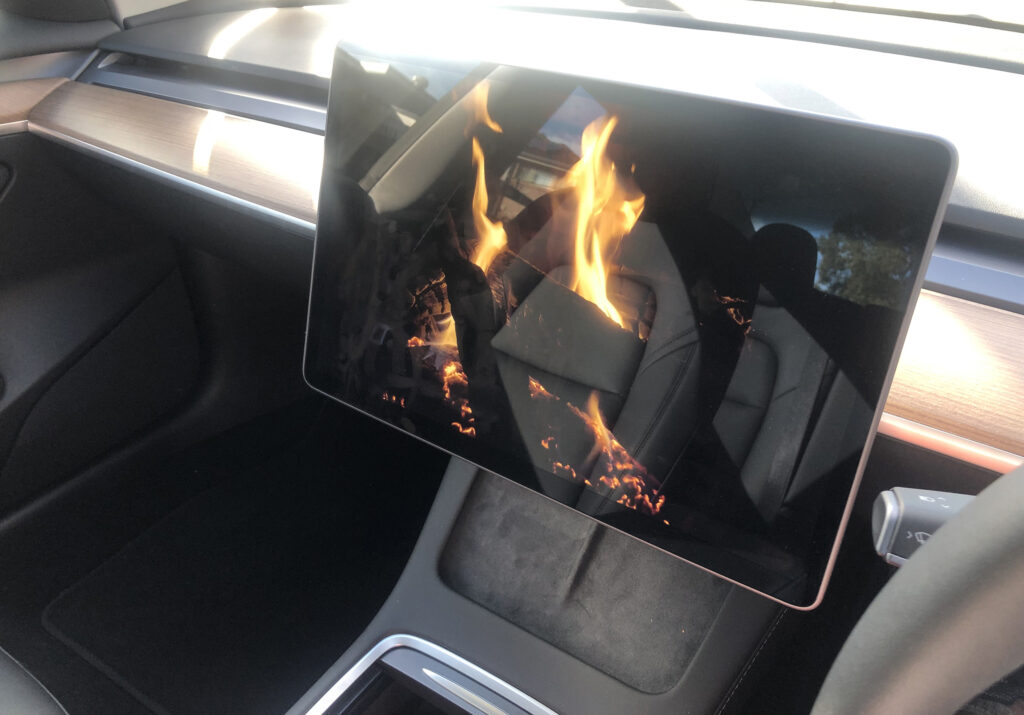
That touchscreen is the nerve centre of the Model 3. It not only controls all the infotainment but also displays the speedo and other drive information such as whether you’ve selected Drive or Reverse.
And in case you one to easily get bored there are all sorts of unexpected trinkets hidden within the screen. Arcade games are in plentiful supply and there’s a customisable whoopee cushion that can deliver fart noises to keep the kids giggling. There is also a Romance mode that display appropriate video images on the screen and some crackling of wood as it burns. Karaoke? Tesla calls it Caraoke, but it’s embedded as well.
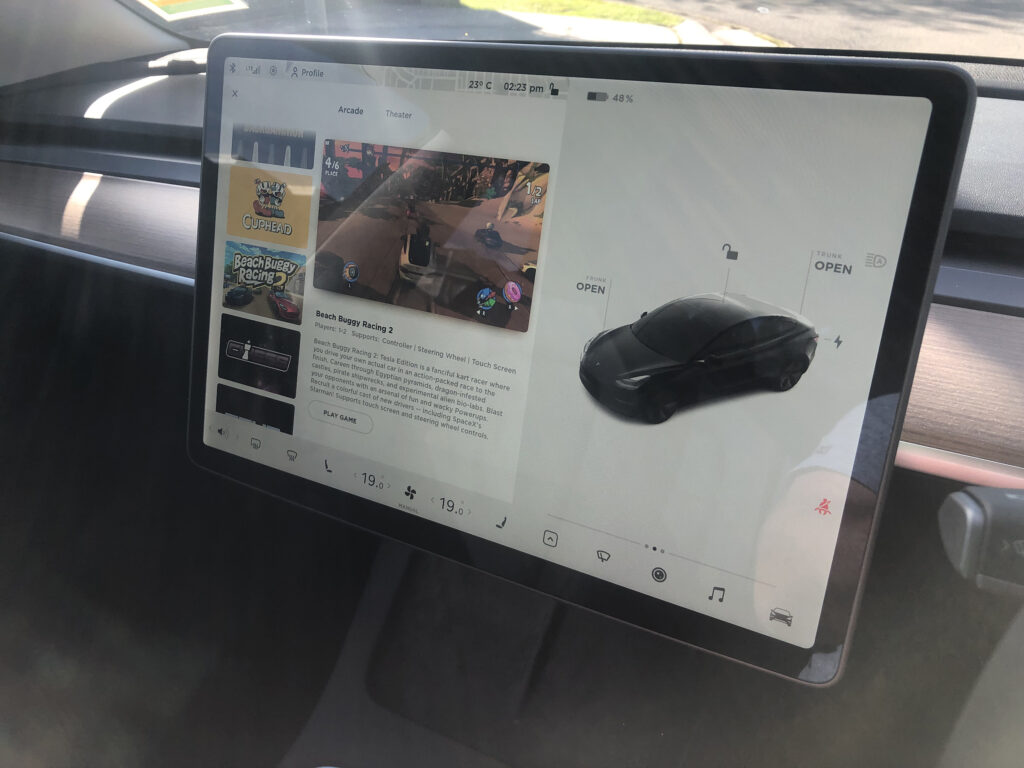
Two USB-C plugs in the centre console take care of gadgets plus there’s a USB-A port in the glovebox for downloading footage from the dashcam cameras and Sentry mode that keeps an eye on the car when it’s parked.
The stuff that looks like leather isn’t, instead you get a fake trim that helps Tesla badge the car as vegan.
There are 18-inch wheels with a classy grey finish, although that finish is a plastic cover over the alloy wheels; only Tesla can make plastic wheel covers fashionable again! If you can do without some aerodynamic efficiency the 10-spoke alloy wheels hiding behind those covers arguably look even better.

The only standard colour is white, with black silver and blue another $1500 and red adding $2900. The black interior can also be replaced with white for another $1500.
There’s also Tesla’s semi-autonomous Autopilot system (similar to level 2 driver assist systems now common on new cars). To get the more advanced Full-Self Driving (FSD) system it’s about $11,000 more and the car will be upgraded via over-the-air software updates as the tech becomes available and regulatory approval for its use is given. Considering FSD is already running years late and there’s no firm time frame on its arrival, it could be a better bet to keep the money in the bank.
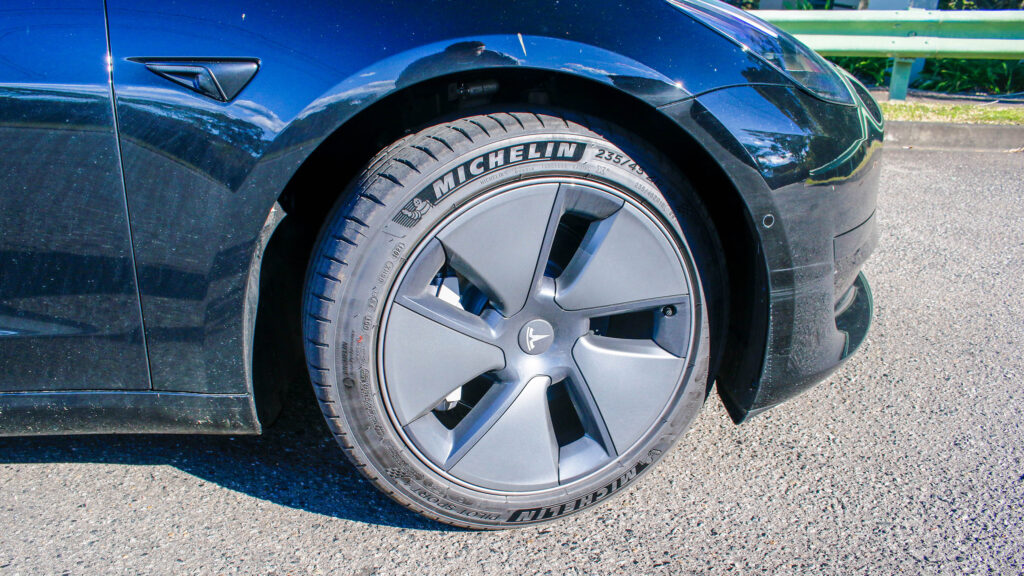
Yet at the same time there are obvious omissions some in the EV space may miss. There’s no key, with Tesla instead encouraging people to use their smartphone. If you want a physical key it’s a few hundred dollars as an option.
There’s also no head-up display and no Apple CarPlay or Android Auto phone connectivity. As with many EVs, there’s also no AM radio, although the music streaming options provide plenty of alternatives, including the ability to stream radio.
Inside the Tesla Model 3
It’s a stark, minimalistic cabin that is unlike any prestige car. Yet it somehow works with what Tesla is trying to achieve: tech over everything else.
That partly puts the focus on the 15-inch central screen, which controls almost everything in the car. Glovebox, boot, bonnet, seat adjustment, steering wheel adjustment, audio, navigation and more… it’s all done through that screen.
Operating a Tesla will be a big change for most drivers of other cars. It’s as significant as switching from a PC to a Mac or offloading an old touch button phone and going for a smartphone.
It pays to spend a while going through it all first so you can get your head around it all before you’re cruising along at 30 metres per second.
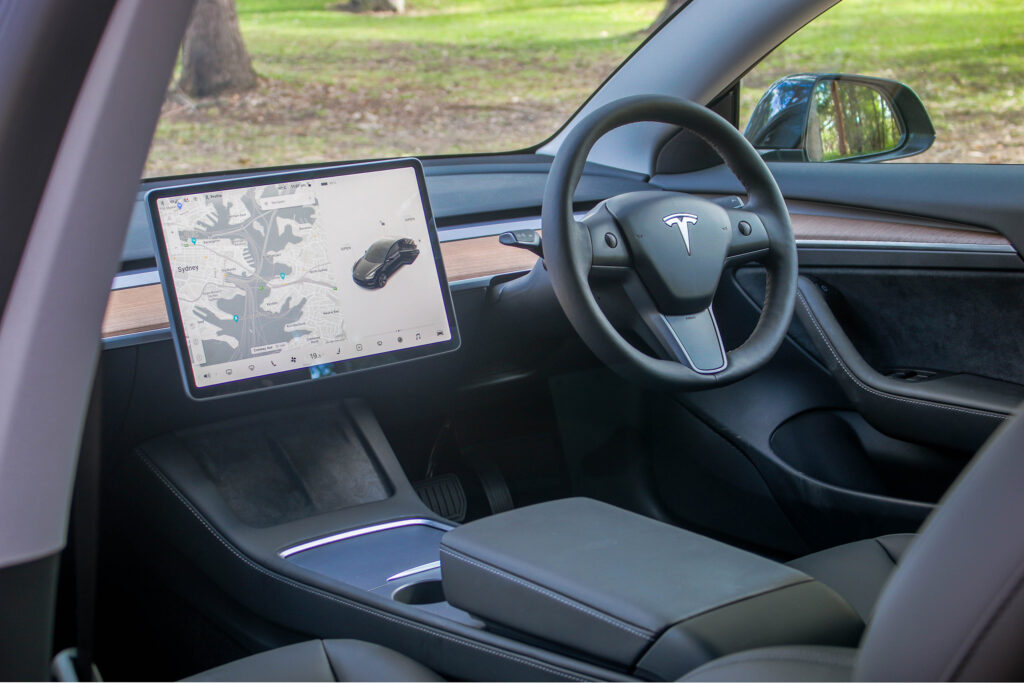
The windscreen wipers default to Auto, for example, which was no help to us when we entered a tunnel and the windscreen fogged up almost instantly. No point fumbling for a stalk because there ain’t one. Fortunately we knew where the wiper icon was and were able to manually switch them on to restore visibility.
There aren’t even air vents, with a pinch and zoom of the centre screen instead changing the airflow.
Not everyone will like the panoramic sunroof, especially in summer. While it’s tinted to dull the sun’s rays, there’s still potency and heat on a hot day.
No issues with space, though, at least up front. From the driver’s seat you can only just see the tops of the wheel arches, the bonnet falling away fairly dramatically. Vision is good, though, and the cabin has an open, airy ambience.
Leather-look seats are very obviously fake, but Tesla doesn’t try to hide that. The wood trim across the dash breaks up the blandness.
Those in the back get air vents, which they’ll need if the sun is out because that sunroof gives them a great view of everything that bright orb can muster.
The floor is flat, but it’s unnaturally high, meaning tall people will have to deal with having their knees higher than usual. Similarly, knee space is only OK, more kid-friendly than adult-ready.
To some extent that’s the nature of mid-sized sedans, where the emphasis tends to be on those up front. Even refinement is focused on the driver and front seat passenger; the Model 3 has double glazed side windows up front whereas the rear is just a single pane of glass that won’t supress wind and road noise as effectively.
Luggage space is generous with 542 litres in total between the frunk (front trunk, which is under the bonnet) and boot. The front storage area is compact and best left to small bags or the charging cables. The boot is more useful although the sedan configuration and its small-ish opening limits usefulness for stuffing large items aboard. Bike riders will likely need to remove the front wheel to load their ride.
Now, on to build quality. Teslas have traditionally had poor fit and finish, with misaligning panels and inconsistent gaps and finishes. Many have wondered whether those from the newer Chinese factory would be any better.
Our brief initial inspection suggests there has been an improvement, but on our car there were also still issues. The join between the boot, rear panel and tail light assembly, for example, was different on either side of the car in the way everything matched up (or didn’t match up). When $20K cars do an infinitely better job it’s an indication Tesla has plenty of room to improve. Tesla chief Elon Musk has previously acknowledged the brand’s quality issues, even suggesting buyers wait until a factory has been running a while to get better fit and finish.


There’s also a chance Tesla will add to or improve the Model 3 throughout its life using the over-the-air software update facility. Tesla pioneered OTA updates, which are similar to those on a smartphone, sometimes bringing big changes, other times tweaking or smoothing how existing features work.
Performance and efficiency
Tesla is secretive about exactly what’s beneath the skin of most of its cars.
There are no official power figures for the Model 3 SR+ and the capacity of the battery is not disclosed.
In certifying the car for sale with the Australian government, Tesla stated the Standard Range Plus makes 239kW of power, which is about double that of your average small hatchback.
Instead, Tesla tells you the car will hit 100km/h in a claimed 5.6 seconds using a single electric motor powering the rear wheels.
Performance is thoroughly acceptable, especially when taking off. And at any suburban speed it never feels undernourished. Even on a country road there’s ample in reserve for darting up a hill.
Comparing it with its traditional ICE rivals is a no-brainer. The Model 3 kills any BMW, Mercedes-Benz or Audi mid-sized sedan for throttle response and refinement. It’s near silent and responds almost instantly to any prod of the throttle.
And for where it sits in the market performance is thoroughly respectable, too. The Model 3 SR+ does its best work below 60km/h, faithfully building pace and generally having plenty in reserve for ducking into a gap or performing an overtake.
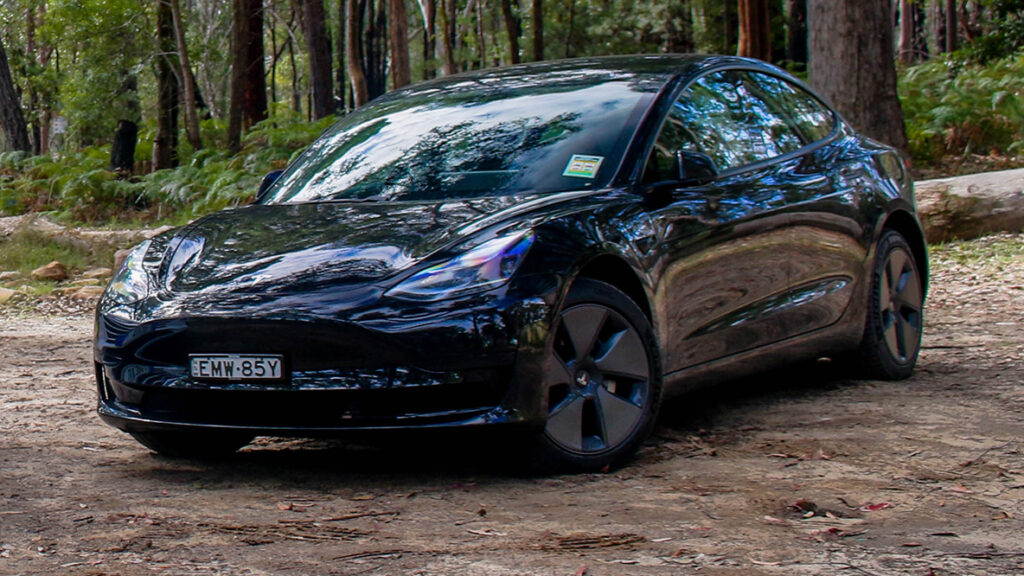
While it only drives the rear wheels – other Model 3s drive all four – there’s enough weight to ensure good traction when accelerating.
Unlike other Model 3s, the Standard Range Plus doesn’t allow adjustments to the regenerating braking, so when you lift off the throttle it’s like you’ve instantly brushed the brake pedal. The cruise control system helps overcome that on-off jerkiness, but otherwise it calls for accuracy with your right leg.
There are various settings (yep, they’re all contained within that touchscreen) for how the car behaves regarding regen and creep. If you want, for example, you can have it creep off the line once you take your foot off the brake, as an automatic transmission ICE car would. Or you can have it hold.
Similarly, you can have the regen operate up until the car is stationary, allowing one-pedal around-town driving if you’re good at judging when to lift off the throttle.
Where the Model 3 SR+ will lose out against its ICE rivals is in high speed stuff, where electric cars typically struggle. Flog it down an autobahn and we’d be prepared to bet any German sedan would be a far more convincing machine.
But we’re in Australia, where the speed limits in most states top out at 110km/h (the Northern Territory has some 130km/h stretches). And the reality is the performance is better than most cars for this money.
Efficiency is even better. We found the Model 3 SR+ used around 16kWh of electricity per 100km. That makes it among the more efficient EVs on the market, and it’ll usually cost a lot less to run that most ICE cars.
But you can forget about achieving Tesla’s claimed 508km of driving range; perhaps that’s why Tesla stopped using those figures in mid-2021 and instead adopted more realistic WLTP range figures. That’s measured to an old standard that is notoriously unreliable. The reality is it’d have to be a very big hill or some super special driving to achieve that.
Something around 400km is closer to the mark, although that will depend on how and where you use the car. Park it for long stints with things such as Sentry Mode operational and the battery will drain more when the car is parked. And like all EVs, cold weather will hurt range.
Obviously solar electricity or that taken from Tesla destination chargers will often be free. If you’re charging from home you’ll likely pay a little over $4 for every 100km of driving. If you’re using a Tesla Supercharger (which currently charges 52c/kWh) then you’ll be paying more like $8.60 per 100km, which is similar to some of the more efficient hybrid or diesel cars on the market.
Charging
Teslas run a standard Type 2 CCS plug for charging. That the same as most modern EVs and means they can access most of the modern chargers increasingly springing up around the country.
They can also access the vast Tesla charging network that includes destination chargers (slower) and Superchargers (fast). So Tesla drivers have access to more EV chargers than those from other manufacturers, who can’t use the bespoke Tesla chargers (a digital handshake between car and charger only allows Teslas on the Tesla chargers).
Chinese-made Tesla Model 3s have a slightly bigger battery capacity than those sourced from California. That’s to account for the different battery chemistry. Chinese Model 3s gets a lithium iron phosphate (or LFP) battery (replacing the US car’s lithium nickel cobalt aluminium oxide batteries). Those LFP batteries have a lower energy density (they can hold less electricity assuming the same size) but should be cheaper to manufacture. As a result Tesla added about 5kWh to the usable battery capacity to ensure the range was similar to those other cars. That means the battery pack is bigger, which in turn means the car is heavier.
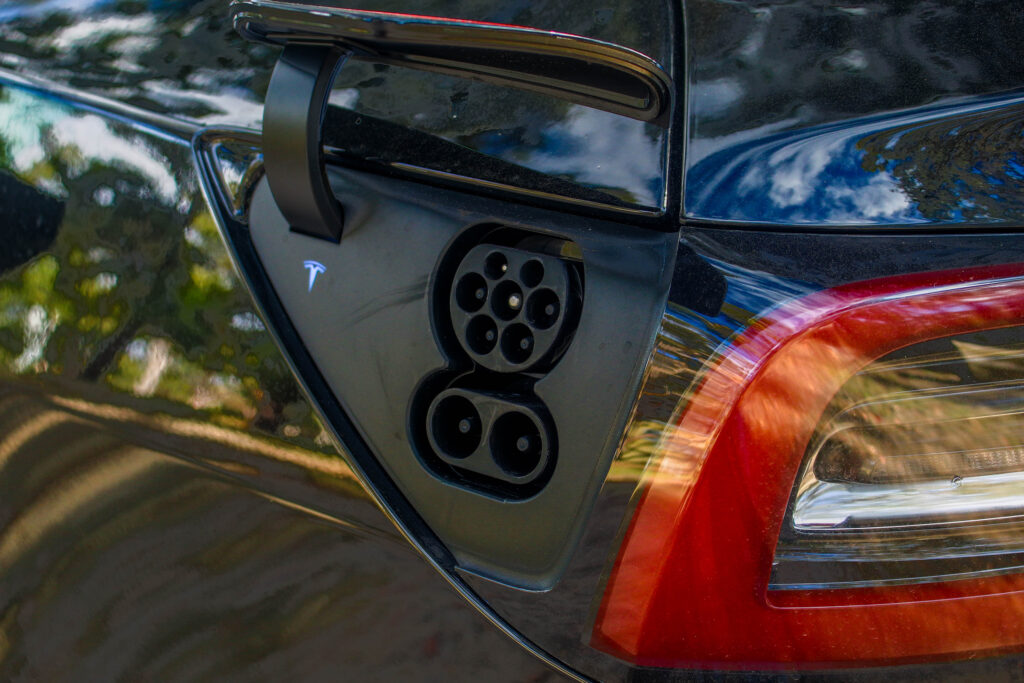
There are pros and cons to the new battery chemistry. One big advantage is that where the old Model 3 battery didn’t like being kept fully charged, the new one doesn’t have the same problem. So whereas many Tesla owners only topped up to, say, 80 or 90 percent state of charge, with the new car there’s no issue constantly taking it to 100 percent.
Getting that full charge is slightly trickier. On a Tesla destination charger the most it will accept is 11kW, so you’re looking at more than five hours for a full charge. From a home powerpoint that’ll stretch out to almost 25 hours.
However, Teslas come with a regular 10A power adapter as well as a 15A one, the latter reducing that charge time to about 16 hours – if you have a 15A outlet.
We found DC fast charging speeds to be finicky. One charge we completed on a 350kW charger saw the charge rate peak at a tad under 47kW, which is disappointingly low. It took more than an hour to fully charge.
There’s been plenty of chat about vehicle-to-grid or bi-directional charging, whereby EVs can feed back into the grid or be used to power a house or business. Tesla has remained quiet on this, with some suggesting it’s because the company doesn’t want to deter people from buying Power Wall home battery systems.
Ride and handling
You don’t have to drive far to realise the Model 3 has been set up for sporty dynamics. The steering is very reactive and it points assertively.
It’s a fun and deceptively capable car, especially if you unleash it on a nice set of corners.
Decent Michelin tyres provide the final piece of what is an athletic handling puzzle.
It’s also relatively quiet and relaxed around town, but a freeway cruise leads to more of a rustle of wind and roar from the tyres. It’s not as at home on those long distance cruises, especially compared with some German rivals.
The suspension also tends towards firm, something more pronounced at lower speeds. The fun factor certainly dominates over compliance.
Anything above about 50km/h settles the suspension nicely, and it’s well controlled.
While we’re talking about how it drives it’s worth mentioning Autopilot, the misnamed system that offers driver assistance but still requires the full attention of the driver at all times.
We found it generally worked well on a freeway, although there were times when it overreacted to other vehicles and got unnaturally close to them. Any re-engagement of correction to the steering often lacks finesse, too, like someone has grabbed the wheel to jerk it back into its lane.
In more challenging scenarios and where lane markings are less obvious or non-existent the Model 3 was far less convincing. While Tesla would have you believe we’re all about to let the cars take over, the experience of Autopilot suggests there’s a long way to go.
Party tricks
Where to start…
Being able to set the indicators to make fart noises seems a logical place to kick off. You can even change which speakers the variety of strained squirts and squelches comes from, so as to apportion fart blame to other occupants.
Then there are the arcade games, which include everything from a basic car racing setup (you use the steering wheel and pedals when the car is stationary) to chess. By now you should be getting the idea that Tesla life is very different to the seriousness of an Audi or BMW.
Dog Mode is another good one. It keeps the AC operating while a pet is locked in the car and even displays the cabin temperature on the screen so passers-by don’t panic.
And there are many more. Tesla prides itself on having a bit of fun while rethinking the way cars operate.
Safety
The Model 3 scored the maximum five-star ANCAP safety rating in 2019. Since then, the requirements for a five-star rating have stepped up.
Delve deeper into the results and it performed very well for front adult occupant protection although not quite as well for rear seat child protection.
The Model 3 gets six airbags (dual front, front side and side curtain airbags protecting the heads of outboard occupants in a side impact).
There’s also auto braking that operates from 5 to 150km/h at day and night.
Those wanting to set the cruise control to the speed limit can do so, allowing the car to read the road signs and adjust the speed accordingly.
Verdict: Model 3 Standard Range Plus
It’s the cheapest ticket to Tesla ownership and the Model 3 Standard Range Plus is one of the better EVs currently on the market. Other Model 3s go faster and further, but the Model 3 does plenty of the EV gruntwork at a price that could tempt people out of traditional petrol and diesel cars.
There are adjustments along the way: it’s not as well put together as other brands and the interior leans heavily on that big centre screen over creature comforts. And like going from a Nokia to an iPhone it’s a learning experience working out how everything operates in a car engineered in Silicone Valley.
But the Model 3 blitzes its rivals with gadgets and gizmos and occasionally useful extras that help it stand out in a crowded market.

Throw in an athletic driving manner and the promise of low running costs and it makes for a tempting EV proposition. The fact that it manages all that in a mid-sized sedan – the car type that is dying off throughout the motoring world – is testament to the appeal of the Model 3.
Naturally, the Model 3 has multiple targets on its tail, something that could change the dynamic over coming years.
Our Tesla Model 3 was supplied by AGL, which now offers EV subscriptions. The Model 3 Standard Range Plus is available from $420 per week.
Want to sample the Tesla Model 3 Standard Range Plus? Click here.
2021 Tesla Model 3 Standard Range Plus specifications
Price: About $65,000 drive-away
Basics: EV, 5 seats, 4 doors, mid-sized sedan, RWD
Range: 400km (realistic range; forget the Tesla claims)
Battery capacity: 55kWh (estimated)
Battery warranty: 8 years/160,000km (guarantee of 70 percent of original battery capacity)
Energy consumption: 15kWh/100km (approximately)
Motors: 1 rear, 239kW
AC charging: 11kW, Type 2 plug
DC charging: TBA, Type 2 CCS combo plug
0-100km/h: 5.6 seconds (claimed)

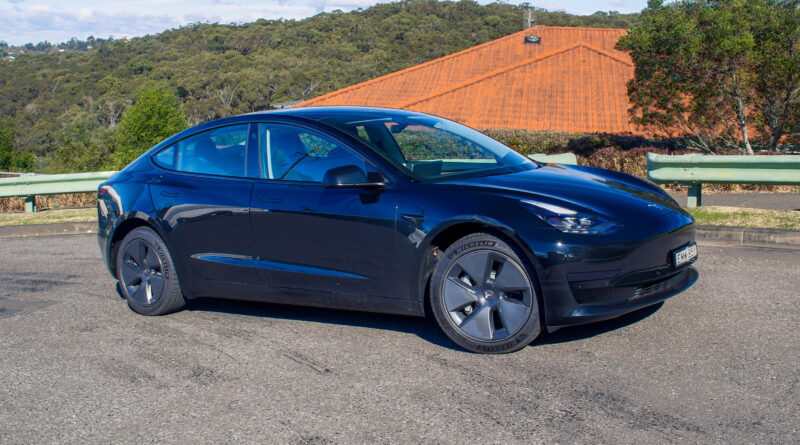
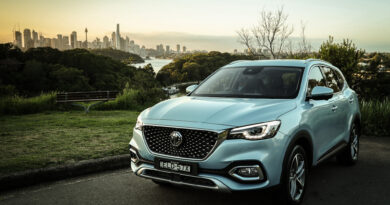
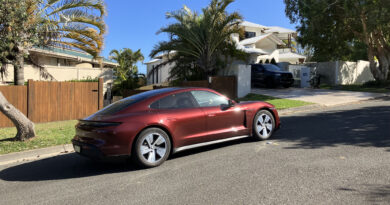
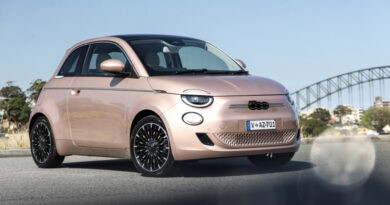
Our Chinese-made Long Range Dual Motor was delivered late March. The car wasn’t professionally presented on delivery, to say the least, but Tesla did their best to address our disappointment quickly. They need to engage a different carrier to deliver their regional South Australian orders.
Our car is well built. The exception is a couple of intermittent buzzes from the interior plastics, which we’ll hunt down and hopefully fix ourselves. Apart from that, it’s absolutely fine. Panels line up, paint is great, everything opens and shuts properly.
It drives beautifully. We took it for a drive through the Adelaide Hills and it was huge fun, steering like a go-kart. And so quick! Having sold a VE SSV just before delivery, which we loved, I can confidently state the Tesla would eat it for breakfast. We both ride litre-class road bikes and it’s not that quick, but its mighty impressive.
We upgraded our solar and had a home battery installed in preparation for our EV. we won’t get our money back but that’s not actually the point. We’ve put our money where our mouths are. We want to be part of the solution. Our next car will be a cheap(er) second EV, if we can manage it.
Cheers, Dave